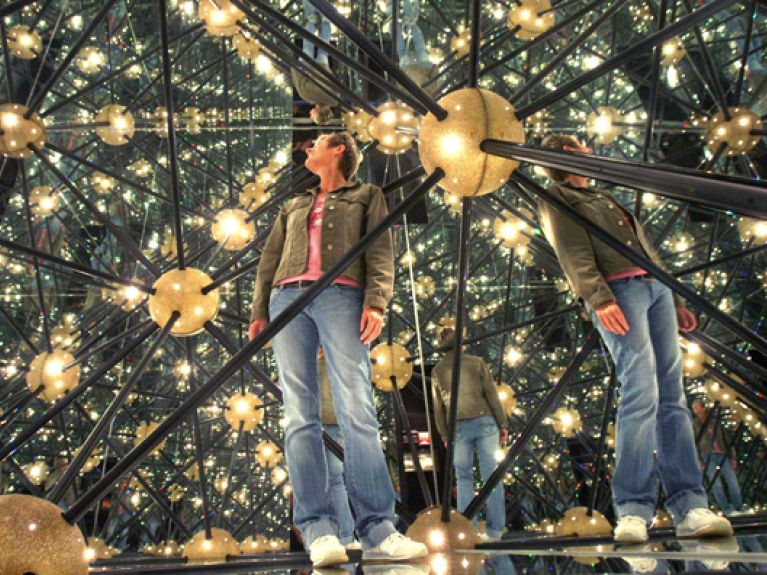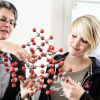Europe’s supermicroscope
The European Spallation Source (ESS) in Lund will offer unique opportunities for research – as will other jointly planned large-scale facilities.

In a technologically advanced society, research is an important aspect of providing for the future. Yet the more we know about the world, the more difficult it becomes to make new discoveries. Scientists often need large and complex research infrastructures, such as telescopes or particle accelerators, to be able to find out how the universe was formed, for example, or how the properties of materials are determined by interrelationships at the atomic level.
Building such installations can cost billions of euros and keep hundreds of specialists working for years. But it’s definitely worth the effort in many respects, because it not only leads to scientific findings and opens up new areas of research, it also creates attractive jobs and regularly leads to technological innovations. For example, we would not have the Ceran hob if astrophysicists had not needed larger telescope mirrors. And scientists at the European Organization for Nuclear Research (CERN) ended up making a decisive contribution to the creation of the Internet as they looked for ways of improving communication.
Individual countries have neither the funds nor the personnel to build and operate such large-scale facilities on their own. In order to use funds efficiently and make the long-term planning of research infrastructures possible, both Germany and the European Union have created their own structures – for example, the national “Roadmap” of the Federal Ministry of Education and Research and the European Strategy Forum on Research Infrastructures (ESFRI). Other projects in Germany have also been successful in competition with each other, such as the Facility for Antiproton and Ion Research (FAIR) near Darmstadt, under construction since 2011, and the European X-ray Free-Electron Laser (XFEL), a project launched in 2009, which is being built in Hamburg.
FAIR is an accelerator facility, which, among other things, will generate ion beams of unprecedented intensity. Starting in 2018, some 3,000 researchers will be able to use it to investigate important questions like the early development of the universe or the structure of matter. XFEL aims to generate ultrashort laser flashes of X-ray wavelength – 27,000 times per second and with a peak brilliance that is a billion times higher than that of the best conventional X-ray sources. From 2017 onwards, international research groups will be able to use this intense light for days or weeks – for example, to decipher the molecular composition of viruses and cells or to film chemical reactions. The XFEL is closely linked to the Helmholtz Association’s Deutsches Elektronen-Synchrotron (DESY), one of the leading centres of research into matter. The idea for the X-ray laser facility was first floated at DESY.
A major infrastructure project in Sweden also aims to create new ways of investigating materials. The European Spallation Source (ESS) in Lund is the world’s most powerful neutron source. Neutrons are the uncharged building blocks of atomic nuclei. They can show researchers where atoms are and how they are moving. They can therefore be used by science as a kind of supermicroscope and provide unique insights into matter. Their electrical neutrality enables neutrons to penetrate deep into samples without destroying them. Furthermore, they act as tiny magnets, allowing them to recognise the magnetic order in a material, rather like a compass needle measuring the Earth’s magnetic field.
The ESS is a joint European project and is supported by 17 countries. The construction costs have been estimated at approximately 1.84 billion euros. Sweden will pay the largest share of 35%. Germany is contributing 202.5 million euros to the construction costs, plus 15 million a year towards operating costs. Instruments and personnel will make up a large proportion of Germany’s contribution. The Helmholtz Centre Geesthacht and Technische Universität München (TUM) are also participating – alongside Forschungszentrum Jülich, which is coordinating Germany’s contributions. Each institution is offering its special skills to ensure that the European supermicroscope can go into operation as planned in 2023.
The ESS will generate a maximum of about 30 times as many neutrons as today’s facilities, and its operations will be climate-neutral. Free neutrons do not occur in nature, and there are two possible ways of releasing them from atomic nuclei: by nuclear fission in research reactors or using the more modern method of spallation. Spallation means “chipping” – and that is exactly what happens to the neutrons in the ESS: an accelerator takes bursts of protons up to close to the speed of light and points them at the atomic nuclei of a rotating, helium-cooled target device made of eleven tonnes of tungsten. The impact releases some neutrons directly and simultaneously energetically charges the heavy-metal nuclei, so that 20 to 30 neutrons are released from each nucleus.
At a speed of 20,000 kilometres per second, the released neutrons are much too fast and energetic for experiments. Tanks filled with water or liquid hydrogen are therefore used to slow them down to the optimum speed. Long, vacuum-filled tubes, the neutron guides, then direct them to the experimental stations. The neutrons “bounce” off the atomic nuclei of the samples and can change their direction and speed in the process. The nature of this scattering can be measured with detectors and provides information on the arrangement and motion of the atoms and molecules in the sample.
Every year, 2,000 to 3,000 scientists from universities, research institutions and industry will use the ESS for their work. In combination with novel instruments, it is hoped the ESS will enable them, for example, to observe materials for hydrogen storage systems to see how they react with hydrogen. Such materials are urgently needed, for example, to store and transport renewable energies – a key challenge for the future. ▪
ANGELA WENZIK is a science journalist at the Forschungszentrum Jülich.

